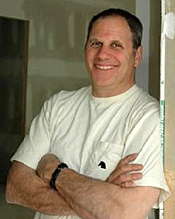 This week I was honored to be included in Leah Thayer’s “Best Practices” post on Daily 5 Remodel. For those of you who may not Leah she has earned the respect from many of us in the building & remodeling industries over the last 20 years as an award-winning business journalist. She grew up in a family involved in building homes & spent 6 years working as Senior Editor for Hanley Wood’s Remodeling Magazine which was when I first had the pleasure of talking with her.
This week I was honored to be included in Leah Thayer’s “Best Practices” post on Daily 5 Remodel. For those of you who may not Leah she has earned the respect from many of us in the building & remodeling industries over the last 20 years as an award-winning business journalist. She grew up in a family involved in building homes & spent 6 years working as Senior Editor for Hanley Wood’s Remodeling Magazine which was when I first had the pleasure of talking with her.
UPDATED: Unfortunately D5R has closed its doors, but we were allowed to capture the post before the lights were completely turned out. Leah, you had a great run & let me offer from many of us our thanks for all the great memories & work you did for those in the remodeling industry.
Doug Selby, Ann Arbor, Michigan: Meadowlark Builders and Meadowlark Energy
 Energy Myth to bury: I can’t sell green because my customers won’t pay for it.
Energy Myth to bury: I can’t sell green because my customers won’t pay for it.
Reality to respect: Focus on quality insulation and air-sealing. Remodelers sometimes think they should go with the cheapest price for things the customer doesn’t see. There’s a world of difference between average insulation jobs and great ones. Never go by price alone.
Inferior insulation jobs usually involve fiberglass or cellulose, although those materials can make a good product if good air-sealing is done first. Does the insulator test out with a blower door? Does the insulator have a plan for how they air-seal? One reasons spray foam tends to work better is that it air-seals at the same time it insulates. So the contractor has a better chance of getting a good product (although I’ve seen plenty of botched spray foam jobs too!). If the insulator offers “tri-polymer foam,” chances are he is not a quality leader. While it is easy to install and make a quick buck doing so, it does not perform as intended over the long term.
My favorite ways to insulate these days include Owens Corning spray caulk (they call it EnergyComplete) and rock wool batts. Superior air-sealing and high R-value, completely toxin-free and fireproof.
Sean Lintow, Sr. Naperville, IL: SLS Construction & Building Solutions LLC
 Myth to bury: It drives me crazy when people look only at a project’s potential energy savings and “ROI” — especially when these are the same people who espouse the house-as-a-system concept. While I wish we could say that this mindset is strictly limited to government programs, the sense that “I can’t replace that piece of damaged insulation on the a/c line set since I don’t know how much it will save” has unfortunately spread far and wide.
Myth to bury: It drives me crazy when people look only at a project’s potential energy savings and “ROI” — especially when these are the same people who espouse the house-as-a-system concept. While I wish we could say that this mindset is strictly limited to government programs, the sense that “I can’t replace that piece of damaged insulation on the a/c line set since I don’t know how much it will save” has unfortunately spread far and wide.
I don’t know about many of you, but I can’t recall the last time I was asked for the ROI on granite. Doing things right from the start might not have upfront savings, but the referrals from happy comfortable customers sure do.
Reality to respect: Green building has never been about products. It is about the systems and the people doing the work. That said, and following up on the pet-peeve above: Never stop learning and challenging your own beliefs and those of others.
For example, plastic has no place in walls. (Rumor has it goes bye-bye in the 2015 code.) There is a reason that the P in Global Warming Potential stands for potential (maybe it should just stand for poor science). The model of sizing air conditioners at 500 square feet per ton is long gone (try 800 to 1,500 square feet). And just because you have done something for 25 years doesn’t mean that it is right or ever was.
John Nicholas, Wichita, Kansas: Efficient Energy Savers
 Myth to bury: Insulation stops air leakage.
Myth to bury: Insulation stops air leakage.
Reality to respect: If you really want to stop air leakage, caulk all openings at electrical pass-throughs, plumbing pass-throughs, sill plate edges, top plate edges. Properly flash windows and seal effectively.
We make a lot of great airplanes here in Wichita. They don’t have thick walls; in fact, the walls contain more in the way of wires and control cables than insulation. These planes fly at 40,000 feet and the air outside is minus-40 degrees F. Yet the inside of the air craft is 70 degrees F. How do they do this? They build an airtight aircraft.
We can build houses that are much tighter then we currently have. If we will only shift our focus to building and remodeling correctly in the first place, we will enjoy lower energy bills and better quality of indoor air. In other words, no more incoming air through the wall past the mouse droppings, moldy insulation and other nasty things that are in our walls now.
Doug Walter, Denver, Colorado: Doug Walter Architects
 Myth to bury: The idea that photovoltaics are sustainable — that all you need to do is frost a building with PVs to offset your leaky envelope and incandescent lighting package.
Myth to bury: The idea that photovoltaics are sustainable — that all you need to do is frost a building with PVs to offset your leaky envelope and incandescent lighting package.
Reality to respect: Invest in energy modeling from the get-go to inform design. Architects and designers would get much more bang for the buck by utilizing a user-friendly energy modeling software in-house, rather than waiting until late in design to outsource energy modeling to a consultant who will give you one report. Having modeling capability on the team from day one allows you to pose dozens of those “what if” questions at every step along the way, and to make intelligent decisions backed by science.
Two fairly user-friendly modeling programs I like are Rem/Rate by Architectural Energy and EnergyGauge. And don’t overlook the old standby, REScheck, available from the Energy Department. It’s free and has been around forever, and each version gets better.
The important takeaway is to use something to predict energy performance, then go back and check actual consumption so you can adjust your future modeling based on how well the first one worked. Of course, owner behavior has a lot to do with performance, and no software can model that.
Carl Seville, Atlanta, Georgia: Seville Consulting
 Myth to bury: Spray foam insulation is the answer to everything.
Myth to bury: Spray foam insulation is the answer to everything.
Reality to respect: Focus on exterior moisture management: perfectly flashed weather barriers, including all windows, doors, pipes, wires and ducts. This is a particular problem in existing walls where you cannot identify if there is an existing weather barrier, and if the siding is to remain, you can’t flash new openings. Particularly in wet climates, the only real answer is to strip the siding off any area of the house being worked on, install or repair the weather barrier, and then replace the siding. Preferably with a vented rain screen.
Michael Klement, Ann Arbor, Michigan: Architectural Resource
 Myth to bury:part series on debunking green myths for Qualified Remodeler magazine. So, which one to pick … I’ll go with door number one from my series: Green costs too much.
Myth to bury:part series on debunking green myths for Qualified Remodeler magazine. So, which one to pick … I’ll go with door number one from my series: Green costs too much.
Reality to respect: Not So Big™ inspired design. As I wrote for QR, “Helping our clients recognize through intelligent, thoughtful, inspired design they can have everything they want but in a smaller, more efficient package is a green strategy of the highest order.”

Sean — Thanks so much for this warm shoutout. One reason I’ve enjoyed my work so much is because of remodeling pros like you — always working to build better and share the knowledge! Thanks for weighing in on the “green myths” story and I look forward to collaborating again soon. Maybe even over a beer in Baltimore next week!
Leah
My pleasure Leah & looking forward to it – I hope our schedules allow for it
Sean — Thanks so much for this warm shoutout. One reason I’ve enjoyed my work so much is because of remodeling pros like you — always working to build better and share the knowledge! Thanks for weighing in on the “green myths” story and I look forward to collaborating again soon. Maybe even over a beer in Baltimore next week!
Leah
My pleasure Leah & looking forward to it – I hope our schedules allow for it